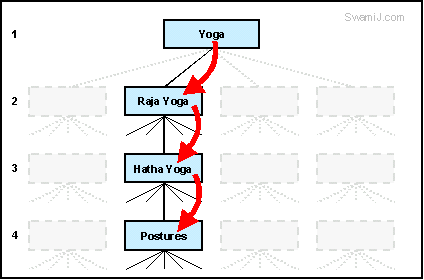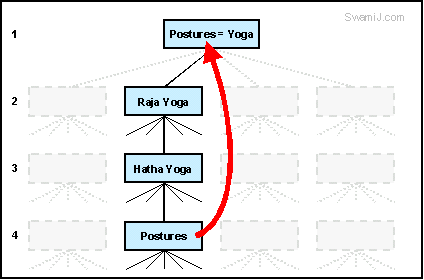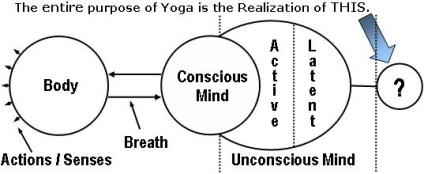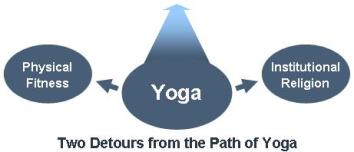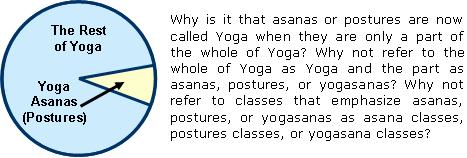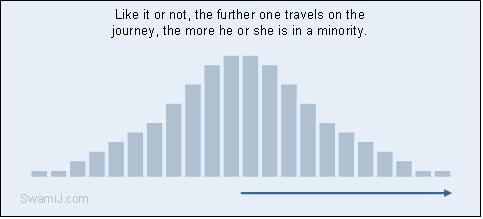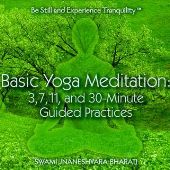|
Home Site Map CDs Is Yoga a religion? Yoga/Vedanta/Tantra 6 Schools |
|||||||||||||||||||||||||||||||||||||||||||||||||||||||||||||||||
|
|
Modern
Yoga versus Traditional Yoga The typical public perception of Yoga has shifted significantly in recent years. This article addresses the nature of those shifts, comparing traditional Yoga of the ancient sages to the modern revisions. The article also includes quotes from nine different teachers whose names are well known. The starting point of most classes, books, magazines, articles, websites, and blogs on Yoga are so different from traditional Yoga of the ancient sages that it can be fairly called "Not Yoga". The wave of Not Yoga seems to morph further and further away from Yoga.
"Traditional yoga" has
historically been taught orally, and there are subtle nuances among
various lineages and teachers, rather than there being some one,
precisely agreed upon "yoga". Principles are usually communicated in
sutra style, where brief outlines are expanded upon orally. For example,
yoga is outlined in 196 sutras of the Yoga Sutras and then is discussed
with and explained by teacher to student. Similarly, the great depth of
meaning of Om mantra is outlined in only 12 verses of the Mandukya
Upanishad and is expanded upon orally. Over 10% of the 700 verses of the
Bhagavad Gita specifically contain the word 'yoga'. This article also does not claim
that there is a single, universal "Modern Yoga". Here also there are
many different faces. However, there has been a quite significant
overall shift in the perception of yoga, and that is worthy of comment
and ongoing examination.
Asana classes and asana studios: It is so unfortunate that the word "Yoga" has so often been used in place of the word "asana" or "posture" in recent years. We would not call a brick a "house" even though it is part of the construction. Yet, this is what is often done with Yoga. The first word of Yoga Sutras is "atha" which means "now," implying a prior preparation. One may do postures for years and finally be ready for Yoga. To call it "Yoga" before that time is a misnomer. If we had "asana classes" and "asana studios" that would be a great service to people. Then the word "Yoga" could be appropriately used for the journey that one begins when truly understanding the history and nature of authentic, traditional Yoga. Yoga Body
Science of Yoga
Yoga "On" and "Off" the Mat: Within the past few decades there has been a new invention, that of the yoga "mat", which is made of some sort of synthetic rubber or plastic material. This has lead to the idea that "yoga" is practiced "on" such a mat. Since the mat is designed to be used for physical postures or asanas, its invention has even further led to the distortion of yoga. Along with the invention of yoga "on the mat", there has been a subsequent invention of yoga "off the mat" to describe the "other" form of yoga. Google presently reveals 1,220,000 results for a search of "yoga off the mat". While it is good that people are doing other such practices, the mere fact that "yoga off the mat" has come into vogue implies that the default position of real yoga is "on" some synthetic "mat". This is just one more example of setting aside the ancient tradition of authentic yoga for the sake of promoting the modern distorted yoga through all of the yoga business channels. Yoga Industry: Yoga or something using the name "Yoga" has gotten so big and has had such great commercial success that there is now a business category known as the "Yoga Industry". Googling the term "Yoga Industry" reveals 92,800 results. The last survey (2008) conducted by Yoga Journal magazine (USA) reports that it is a $5.8 billion per year industry, and that over 34 million people in US either practice yoga or are interested in it.
Yoga Meditation Visualized - Swami Jnaneshvara Bharati
A personal note:
A
small percentage of people find the kind of information in this article
of interest. Some even find it offensive. It is very clear that
virtually nobody is going to be swayed from their misdirected opinions
about the nature of Yoga simply by reading this, as minds tend to hold
their course until some life situation forces them to change.
So
why is this article here? It is here to serve that small number of you
who have come to see that Yoga is far more than we generally see these
days. You may feel completely outnumbered by the current wave of
distortion and devolution of Yoga. I say this because people sometimes tell me such things. You
may feel misled, confused, and alone because your personal perspective
and journey seem out of alignment with your peers and the popular
so-called teachers and styles of Yoga. I hope this article serves as
validation for you, and also provides some explanations and quotes that
you can use for yourself to stay focused in a Yoga world where you are
in a minority. If you are a
sincere seeker of the higher, authentic goals of Yoga, you are on a
sometimes exasperating journey that is filled with joy. It is infinitely
worth the challenges along the way.
In
loving service,
Swami Jnaneshvara
See also
Philosophy, Not
Religion
Funk & Wagnalls New
Encyclopedia
Respected
Western publishers acknowledge authentic, traditional Yoga,
quite unlike many so-called yoga teachers and yoga teacher
training schools. The following is excerpted from Funk &
Wagnalls New Encyclopedia: YOGA
(Skt. yuga, “yoke”), one of the six classic systems of Hindu philosophy,
distinguished from the others by the marvels of bodily
control and the magical powers ascribed to its advanced
devotees. Yoga affirms the doctrine that through the
practice of certain disciplines one may achieve
liberation from the limitations of flesh, the delusions
of sense, and the pitfalls of thought and thus attain
union with the object of knowledge. Such union,
according to the doctrine, is the only true way of knowing.
For most Yogi (those who practice Yoga), the object of
knowledge is the universal spirit Brahma. A minority
of atheistic Yogi seek perfect self-knowledge instead of
knowledge of God....
The final stage, in Yoga
doctrine, rarely can be attained in one lifetime. Usually, several
births are required to achieve liberation, first from the world of
phenomena, then from thoughts of self, and finally from the spirit’s
entanglement with matter. The separation of spirit from matter is Kāivalya, or true liberation....
(more) Two perceptions of Yoga Perception has recently shifted: The typical perception of Yoga has shifted a great deal in the past century, particularly the past couple decades. Most of this is due to changes made in the West, particularly in the United States, though it is not solely an American phenomenon. (Similar shifts have happened with Tantra as well.) Gist of the two perspectives: The gist of the shift can be summarized in two perspectives, one of which is modern and false, and the other of which is ancient and true.
The false view spreads: Unfortunately, the view that Yoga is a physical exercise program is the dominant viewpoint. The false view then spreads through many institutions, classes, teachers, books, magazines, and millions of students of modern Yoga, who have little or no knowledge or interest in the spiritual goals of ancient, authentic, traditional Yoga and Yoga Meditation.
Yoga and Christianity: To say that Yoga is merely physical fitness, as have many Christians, is like saying that Christian communion is merely drinking wine and eating bread with a meal, and that baptism is nothing more than taking a shower or bath. The goal of Yoga is Yoga.
Six schools of Indian philosophy Yoga is a classical philosophy: Yoga is one of six schools of Indian philosophy. These are Nyaya, Visheshika, Mimasa, Sankhya, Yoga, and Vedanta. A brief review of those six schools or systems will easily clarify the true nature of authentic Yoga being a system of spiritual pursuit. (While there is not universal agreement, some consider the teachings of Buddha to be a seventh system or school of Indian philosophy, rather than a separate system, in that his methods come from the same root. In addition, some consider these divisions inaccurate, stating that the only valid Yoga is directly from the ancient texts, the Vedas.)
Yoga Vedanta: David Frawley writes about the nature of Yoga and its relationship to Vedanta in his book Vedantic Meditation, from which the following is excerpted (see more):
Confusion of goals and instruments The body is not the goal: The human body is a beautiful instrument, and should be taken care of. However, the body is an instrument, and is not itself the goal of traditional Yoga. In the science and practice of medicine, a pill is an instrument, but the pill itself is not the goal. In the science and practice of authentic Yoga, the body is an instrument, but the body itself is not the goal. Confusing goals and tools: This can sound like an anti-body perspective, but this is not the case. It is not a conflict between philosophies. Rather, there is a misunderstanding of goals and tools.
None of the lower levels is the goal: In traditional Yoga, the aspirant works with and trains all levels of the being, including relationships, self-exploration, senses, body, breath, and mind. However, none of these are themselves the goal of Yoga. On an authentic path: The aspirant following a path of authentic Yoga:
The goal of Yoga is beyond these: The single goal of Yoga is beyond all of these, while these are the veils that block the realization of the Self, Truth, or Reality that is being sought. Because they are the obstacles, they are emphasized in practice so that they may cease to cover the eternal center of consciousness.
Confusing Vehicles and Destinations: If you are going to the Himalayas, you may first ride in an airplane or car. However, the fact that you are riding in an airplane or car does not mean that you will necessarily end up in the Himalayas. Everyday there are many millions of people who travel in both airplanes and cars, but will not mysteriously or accidentally end up in the Himalayas without that being their goal or destination. The goal or destination of Yoga is Yoga itself, union itself, of the little self and the True Self (While it is not the intent of this article to give a final or conclusive definition of the term Yoga--which can be described in different ways--it has to do with the realization through direct experience of the preexisting union between Atman and Brahman, Jivatman and Paramatman, and Shiva and Shakti, or the realization of Purusha standing alone as separate from Prakriti). The mere fact that one might do a few stretches with the physical body does not in itself mean that one is headed towards that high union, referred to as Yoga.
Many people work with diet, exercise and interpersonal relationships. This may include physical fitness classes, food or cooking seminars, or many forms of personality work, including support groups, psychotherapy, or confiding with friends. When done alone, these are not necessarily aimed towards Yoga, and are therefore not Yoga, however beneficial they may be. Yet, work with body, food, and relationships may very much fall under the domain of Yoga, when Yoga is the goal. The key is the goal or destination one holds in the heart, mind, and conviction. Without that being directed towards the state of Yoga, the methods can hardly be called Yoga.
Fallacy of Composition The misuse of the word Yoga often involves what logicians call the Fallacy of Composition. One version of the Fallacy of Composition is projecting a characteristic assumed by a part to be the characteristic assumed by the whole or by others. It may lead to false conclusion that whenever a person is doing some action that is included in Yoga, that person is necessarily doing Yoga. Some of the examples below might sound silly, but this Fallacy of Composition is what happens when saying that Yoga is physical fitness, stress management, or medical treatment. The goal of Yoga is Yoga, which has to do with the realization in direct experience of the highest unity of our being, out of which the only apparent individuation and multiplicity have emerged. Practices that are not done for that purpose are simply NOT Yoga. Here are some obviously unreasonable and false arguments about the nature of Yoga. These are given as examples of the absurdity of the fallacy of composition.
Here are some other false statements about Yoga, which have unfortunately come to be widely accepted as true.
By understanding the Fallacy of
Composition, and reflecting on simple examples such as above, it is easier
to see through the arguments and widespread misperception that Yoga is about
physical fitness, stress management, or medical treatment. In fact, Yoga is ONLY
about the higher union having to do with pure consciousness, soul, spirit,
purusha, atman, or other such words. Other efforts for lesser purposes may be
quite useful, but they are NOT part of Yoga unless these higher
goals are the underlying motive for the practices.
Reversing the words Hatha was a part - Yoga was the whole: In ancient times, Hatha Yoga was considered to be a part, or aspect of the greater whole, which was called Yoga. The word Yoga applied to the encompassing, or umbrella principles and practices of wholeness. Postures were only a part of the part: In fact, Hatha Yoga itself only partially dealt with the practice of postures, called Asanas. Thus, the postures or Asanas were a part of Hatha Yoga, which, in turn led to Raja Yoga.
Meaning of the word Yoga: All of this has changed in the past few decades. In this time of modern Yoga, when you hear the word Yoga, or see it written, it seldom is used to refer to the whole of Yoga. Rather, the single word Yoga is now used to refer to physical Yoga.
Not merely semantics: This is not merely semantics; it means that when one is trying to refer to, or to follow the whole of Yoga, there is no longer a word, terminology, or name to go with that whole, the higher Yoga, which is the umbrella for the parts. If you say, "I do Yoga," it is automatically taken to mean that you do physical postures alone. While modern Yoga focuses on the physical, it is, in fact, not even necessary to do the physical postures for one to practice authentic Yoga.
No alternative word for Yoga: Rather than simply using the term Yoga when referring to the original, broader, higher meaning of Yoga, one now has to use an alternative word. However, there is no alternative word for the whole of Yoga. Reason for misunderstanding: This use of the term Yoga rather than Hatha Yoga (or, more accurately, Asana) has been a major reason for the misunderstanding that Yoga is a physical program with a spiritual component, rather than a spiritual program with a physical component.
Who benefits from the removal of the spiritual: Some students and teachers of modern Yoga want to remove or ignore the spiritual orientation of Yoga, for a variety of reasons. Because of this, such people actually benefit by dropping the word Hatha from the term Hatha Yoga. By dropping the word Hatha, and calling it only Yoga, they can more easily avoid the fact that the ancient texts, such as the Hatha Yoga Pradipika, so clearly state the spiritual priority of traditional Yoga. They can escape the fact that Ha and tha refer to the subtle energies of Ida and Pingala, the process of Kundalini Awakening, and attaining Samadhi.
The Whole and the Parts The "whole" is "Yoga": Not only has there been a reversal of Hatha Yoga and Yoga, whereby Hatha Yoga (the "part") has been labeled as "Yoga" (the "whole"), but the whole process and scope of Yoga as been effected in our collective perceptions of Yoga. One way of seeing this clearly is to remember that:
Hatha Yoga Pradipika The entire purpose is spiritual: The entire purpose of ancient, authentic, traditional Yoga, including Hatha Yoga, is spiritual in nature. Following are a few points from the Hatha Yoga Pradipika, a 13th century text outlining the practice of Hatha Yoga. The Hatha Yoga Pradipika is possibly the best known and most authoritative text on authentic Hatha Yoga. These few references should make the true nature of Hatha Yoga clear. Click here to read the Hatha Yoga Pradipika The last chapter is entitled Samadhi: It is significant to note that of the four chapters of the Hatha Yoga Pradipika, the last chapter is entitled Samadhi, the higher state of consciousness.
References from the
Hatha Yoga Pradipika:
The following references are from the Hatha
Yoga Pradipika (sutra numbers are in parenthesis). Note how the
emphasis shifts away from postures to breath, kundalini, raja Yoga, and samadhi.
Yoga and Medicine What constitutes success with Yoga: There are many implications to the shift from traditional to modern perspectives on the nature of Yoga. For example, in relation to the success of modern Yoga and traditional Yoga, there are also two perspectives:
Yoga redefined as a medical treatment: Yoga is now seen as a medical treatment, as if it was a mere physical therapy program. There are even efforts to have modern Yoga covered by insurance programs, as treatment for specific diseases. While this is good for the physical health of people, it further convinces people that Yoga is only a physical program. Therapies are useful: Treatment modalities such as Physical Therapy and Occupational Therapy are very useful and needed professions. However, designing such treatment methods and calling them "Yoga" is a tremendous disservice to both those professions and Yoga. Hijacking: To distort the use of the name "Yoga" in such ways is tantamount to hijacking the name "Yoga".
The sole purpose of Yoga is spiritual: Yoga is a systematic program whose sole purpose is spiritual, whether you call it enlightenment, Self-realization, or other similar terms. The purpose for working with the physical body is so that the body is not an obstacle in practices such as Yoga meditation, contemplation, and prayer. Obstacles to these spiritual practices are naturally minimized or completely removed in the process of following Yoga. Yoga is now prescribed for its side-effects: What happens is a confusion of goals. The goal of traditional Yoga is spiritual in nature, and the side effects include physical healing. It is like a physician prescribing a medication for a particular malady, and that drug also having side effects. With a medication, a pill, the drug is prescribed for it's immediate benefit, not for the side-effects. In modern times, Yoga is being prescribed for its side-effect, while its real goal is usually being ignored. This is not to say that people should not benefit from Yoga, even if only a small part is being taught, and even if that small part is being changed, so as to no longer actually be Yoga. Some of the physical therapies being developed in the name of Yoga might be very beneficial to physical health. The truer meaning of Yoga is lost: However, by developing physical therapy programs and labeling them Yoga, and by focusing on one small aspect of Yoga (the physical), we find that the whole, greater, truer meaning of Yoga is lost to those who would seek the higher ground.
top
Yoga and Money Seminars
on making money with Yoga: As if calling Yoga a fitness program,
physical therapy or medical treatment were not enough, it has also
become common to promote Yoga seminars and books in the name of Yoga
being a money making technique. The promoters sometimes don't openly
say that it is for money, but instead use the terms like prosperity,
success, abundance or affluence. This is not
talking about teachers making money by teaching classes; that is an entirely
different matter. This is talking about intentionally using the subtle methods
and powers of Yoga to cause monetary wealth to come your way. Fruits naturally
come to practitioners as a byproduct of Yoga, but to teach seminars on how to
direct your conviction and practices into producing financial wealth is a very
different matter. Tell a big
enough lie often enough Reframe of
attachment, hedonism, and greed: It doesn't take a great deal of
reflection to see that these are reframes of attachment, hedonism
or greed, which have generally been seen as obstacles to
attenuate, rather than goals to be attained. It is sometimes said
that teachers must meet students where they are. This is the
epitome of that process, whereby greedy teachers provide well
packaged and marketed seminars to the greedy students. In this way,
the seekers receive a form of pseudo-validation for their inner
longings of external pleasure. To suggest here that Yoga has nothing
to do with moneymaking propositions is not to say that people should
live in poverty. It is simply a matter of confusing goals and
methods. Yoga is not a moneymaking technique, and any use of Yoga
for such a purpose is a devolution of Yoga. Pandit Rajmani Tigunait,
head of the Himalayan Institute of the USA writes in an article entitled
Real Yoga that:
"Yoga has become the health
and fitness system of choice. This is odd because it is the mind - not
the body - that is the main target of all genuine Yoga practices
....
To regard Yoga primarily as
a set of practices for increasing strength and flexibility while
calming the nervous system is to mistake the husk for the
kernel
." Yoga
and fitness programs Commingling
of methods: The
word Yoga has come into popularity of late. Many other styles of
exercise, ranging from aerobics to calisthenics to jazzercise to kick boxing have come
to be associated with Yoga (Believe it or not, somebody has even come up
with Yoga for dogs!). Two results have come as a result
of this commingling of methods: First, participants
come to believe that these practices are a part of Yoga, which they are
not. Second, the authentic
Yoga is left even further out of view and unavailable. Tell a big
enough lie often enough Admiring those who keep
the names
separate: Some providers of exercise
programs have integrated Yoga postures into their teachings, but have not
used the word Yoga. These people are to be admired for having the
wisdom to not misrepresent Yoga by presenting
co-mingled, or watered-down versions under the name Yoga. In this
way, their students are getting some of the benefits of this small piece
of Yoga, while at the same time not distorting authentic Yoga
in the
eyes of those students. Functional Training:
A good example of programs integrating Yoga principles, but without
hijacking the name Yoga and abandoning its higher goals, is the movement
towards Functional Training or Functional Exercise. From
this perspective, the postures of Hatha Yoga are considered only a part
of this broader physical fitness perspective. The increasing use of
these terms is very good news for Yoga, in that it more accurately
states what is actually being done, instead of deceptively (by omission)
calling the practices Yoga.
top
Seekers
of the spiritual
Skipping
Yoga as a spiritual tool: For
a person longing for spiritual attainment, the path of traditional Yoga may be an
ideal fit, including all of the many aspects that it encompasses. However,
when the authentic seeker of spiritual truths starts exploring the
landscape of paths, Yoga is often not pursued as a spiritual tool
because "everybody knows" (incorrectly) that Yoga is merely a physical exercise program. Appearances
prevent finding authentic Yoga: While
it is not true that Yoga is a merely physical program, it appears
that way to the majority of people. Therefore, because of the appearances,
many sincere seekers are not finding authentic Yoga, which has some of the highest
teachings and practices known to humanity.
Begin with the spiritual: Following authentic Yoga may bring a person not only spiritual realization, but also side effects that might include physical health, reducing or eliminating some diseases, or health promotion. The intent of Yoga is to focus on the spiritual, right from the very beginning. Through such an authentic orientation of Yoga, many fruits will come, including the physical benefits. Reaffirm the true nature of Yoga: The problem is not one of changing the path of those who practice adaptations of Yoga, or only small parts of Yoga. Such people have a perfect right to do as they wish. However, what is needed, is to clearly reaffirm the true nature of authentic Yoga and make this available to the true seekers in a wide array of venues. Fortunately, at least a small percentage of teachers are trying to do this.
top Turning
away from Yoga as spiritual Some
go elsewhere for meditation: Among the teachers, scholars,
authors, and publishers who profess to be experts in Yoga, many turn
away from non-sectarian Yoga Meditation for their own practices of
meditation and contemplation. Almost unbelievably, it is not
uncommon for so-called Yoga teachers to recommend that their Yoga
students practice Yoga for the physical body, but instruct them they
should not follow Yoga to learn practices such as introspection
and meditation.
Compatible with religion: Yoga as a means for spiritual unfoldment is compatible with any religious orientation. It is quite common for people who have pursued the authentic spiritual practices of Yoga to report that they become even closer to own their religious roots. There is no conflict. (See the article, Mysticism, Yoga, and Religion)
How is it that you would NOT do
this: People do not walk into a restaurant
and order a bottle of “Christian communion” with their meal. Rather,
they order a bottle of wine. If one did place such an order, it would be
taken as a joke. Similarly, would we call eating bread with your meal
“Christian communion” or would we simply call it eating bread? Would you
call taking a bath or a shower baptism? Of course not.
But that you WOULD do this?
How is it
that one can walk into a health spa, for example, and order up “Yoga”
and completely disregard its true meaning? Teachers
promoting their religion: Yet,
it is also sadly true that some other teachers of Yoga, both from East
and West, teach in a way that worships teachers or deities that are not
known to the religions and cultures of the students, even further
confusing the issue of what Yoga is truly about (See the paper, Is
Yoga a Religion?). This is not to say that teachers should
necessarily not present their religion. Rather, the point is that
by not clearly acknowledging the difference between their religion and
Yoga, there is a great potential for confusion about the nature of Yoga. Teachers
and students are both deprived: Many modern Yoga teachers are
missing out on authentic Yoga because of their misunderstanding, and these high
Yogic practices are thus not even followed by many of them. In other words, they
cannot teach the more authentic perspectives of Yoga if they do not know about
them. In turn, their students are also being deprived of authentic Yoga and the
wisdom of the ancient sages.
Can a Christian Practice Yoga or Yoga Meditation?
top
Teacher training programs Teacher
training avoids the spiritual: Even
a cursory review of the school and seminar offerings will reveal that in
most modern Yoga teacher training programs, a small percentage of the curriculum
deals with the spiritual aspects of Yoga, which are the true focus of Yoga. Once again, this modern focus on the physical aspects of Yoga
is backwards from the authentic Yoga of the ancients.
Become certified with no face-to-face teaching: The Hatha Yoga Pradipika and the Yoga Sutras are two of the most authoritative texts in Yoga. As an example of the current state of modern Yoga teacher training, the most well known agency in America that claims certifying authority for Yoga schools has structured its standards with such a focus on the physical that it is possible for a student to become a certified Yoga teacher without having spent a single minute in the face-to-face presence of a teacher studying these texts or any of the other traditional Yoga texts. See also the article:
Online Yoga teacher certification for $49.99: As if the state of Yoga and Yoga teacher training were not already bad enough, one online company has started to offer a $49.99 online Yoga teacher training program. All you have to do is purchase their program via credit card, read their material, and take a written online exam, which consists of multiple choice questions. You can become a "Certified Yoga Instructor" and will also receive an online transcript that mentions your score, which can be used "to prove your certified credentials". Interestingly, their promotional material even explains that the certificate that you will receive does not mention the word online.
Teachers told to not speak: Some Asana teachers say that they do understand the authentic goals of Yoga, and would like to share these higher teachings with students. However, some of them who teach at well known "Yoga studios" around the country (USA) have privately confided that they have been directly told by studio owners to not teach this, and that if they do, they will no longer be allowed to teach there. Many other Asana teachers who understand and seek authentic Yoga in their personal lives refrain from sharing this with students out of fear for losing students and their payments for classes. Maybe the pendulum will swing back: While modern Yoga teaching may have gone far off track in recent years, there is some movement towards providing training that focuses on the authentic. It seems that the pendulum has swung so far away that it might slowly be starting to swing back to the real goals of authentic Yoga. A picture is worth a thousand words:
What Yoga has
become in America (Video)
top
Names
and Modern styles of Yoga Recent
inventions: The nature of Yoga is even further confused in the public eye by the way the
methods are promoted. Reviewing almost any list of the best known 10-12 modern
Yoga "styles" will quickly reveal that almost all of the modern Yoga styles have been invented in the last few decades.
Very few
Yoga teachers today will simply teach "Hatha Yoga," the physical
Yoga system of the past (that actually had spiritual goals), let alone the true spiritual Yoga.
Many use a man's name: In addition, many, if not most of the modern "styles" of Yoga have the surname of a currently living man in front of the word Yoga, as if that man, himself, has invented Yoga. This is not to say that these teachers are not competent or even superb in their physical abilities. They may do a very good job within the scope of their teachings. Distorting Sanskrit terms: Several other modern systems have taken an ancient Sanskrit word or phrase that has a specific spiritual meaning, and then adapted that terminology to some set of postures or practices that were not part of the original intent. Trademark of ancient names: In addition, these modern teachers have then trademarked these ancient, traditional names, further misleading an unsuspecting public. This leaves the would-be students with the impression that the current day founder of this brand name system is somehow linked to the original teachings associated with that word or phrase. It further leads people to believe that the new teachers certified by that founder also have some expertise or familiarity with the traditional practice or level of attainment authentically associated with that word or phrase. Modern styles are very suspect: If you were to turn the clock back a hundred years, maybe even fifty, twenty, or less, few, if any of these current styles, systems, or methods of Yoga even existed. Most of the founders of these modern, so-called Yoga styles were not even born. Therefore, these modern styles are very suspect when, at the same time, we say that Yoga is thousands of years old. This is not a mere call to go back in time to some theoretically more pristine era of Yoga. Here, it really has been a case of throwing away the baby with the bath water.
top
What
kind of Yoga do you do? Four
traditional schools of Yoga: Traditionally,
there are four schools of Yoga. If asked, "What kind of Yoga do you
do?" the answer would be one of these four, or a combination of
them. Briefly, the four schools of Yoga are: Karma Yoga: The
Yoga of action, doing the practices while fulfilling one's duties in
the external world. Jnana Yoga: The
Yoga of knowledge or self-enquiry, knowing oneself at all levels
through a process of contemplation and introspection. Bhakti Yoga:
The Yoga of devotion, of surrender to the divine force or God,
practiced in ways consistent with one's own religion. Raja Yoga: The
meditative school of Yoga, such as systematized by Patanjali in the
Yoga Sutras. Six classical schools:
In addition, it is
important to note that Yoga itself has been classically considered to be
one of six schools of Indian
philosophy. What
kind of Yoga do you do?: However,
now, when one asks, "What kind of Yoga do you do?" the
question is almost impossible to answer. The question now is an inquiry
as to which of the many modern adaptations of postures that one
practices, as referred to in the last section. Only
Yoga: A true Yogi, one who sincerely practices authentic Yoga, may do just Yoga,
meaning some combination of Karma, Jnana, Bhakti, and Raja Yoga, in the
context of the six systems of Indian philosophy and practice. The mere
asking of the question, "What kind of Yoga do you do?"
is, itself, a sign of confusion, as one Yogi encountering another Yogi
would not likely ask such a meaningless question.
top
When
is Yoga no longer Yoga? Think
of a car with missing parts: Imagine
you see a car, and your friend says, "What's that?" You say,
"It's a car". Imagine that the car is missing a wheel, and
your friend asks you the same question. Still, you say, "It's a
car". But what if all four wheels were gone, and the doors were
gone, and the engine was gone. Then, what would you say when your friend
asked, "What's that?" You might say something like,
"Junk". We may not know the exact point of change, but somewhere
along the way, in removing the parts, you'd naturally stop saying, "It's
a car".
Think of Yoga with missing parts: At what point, and after how much adaptation to modern culture, does Yoga cease to be Yoga? When Yoga is stripped of its higher goals and methods, can it still be called Yoga? When is Yoga no longer Yoga? Bricks and houses: Imagine that you hold a brick in your hand, and say to a person, "This is a house!" To hold out asanas (postures) and say, "This is Yoga!" makes as much sense as saying that a single brick is a house. Both are confusing a minor, though useful part with the whole.
top
"But it's useful! It helped me!"
One of the most common comments used to justify the modern devolutions
of Yoga is in saying something like, "But it's useful! It helped
me!" It is as if they
think that pointing out the true nature of Yoga is somehow in opposition
to doing other activities that are of benefit to human beings. The
argument is that if people become flexible and less stressed, the method
is therefore called Yoga. The fact that physical postures (or modern revisions) are effective is not
the question. Doing asanas is beneficial, but calling it Yoga is a
different matter. The fact that the brick is useful does not make it a
house. Any physical exercise, such as walking or playing tennis is
useful, but that does not make it Yoga. Aerobics, calisthenics,
jazzercise, and kickboxing may also be useful, but that does not make
them Yoga. Massage therapy, physical
therapy, and respiratory therapy are useful, but that does not make them
Yoga. Psychotherapy and counseling are useful, but that does not make
them Yoga. The argument that the tiny piece of Yoga called asana
is useful is not a legitimate justification to reverse the part and the
whole, and thus claim that Yoga, when stripped of its higher goals and
practices, is still Yoga.
top
Opponents
are providing support Religious
leaders say Yoga is spiritual: Ironically,
some of the most outspoken opponents of Yoga are doing the
most to promote its authentic spiritual nature. Leaders of some
religious organizations are prohibiting Yoga classes from being
conducted in their facilities because of its spiritual nature. They
can be quite outspoken in their condemnation of Yoga. (See
Is Yoga a Religion, including the section on choices
related to Yoga and religion. See also Mysticism,
Yoga, and Religion)
Preventing classes because of being spiritual: In one recent example in the news, a religious leader stopped Yoga classes in his facility because "the Yoga instructor, had confirmed that the ultimate aim of Yoga was to enable participants to " 'ascend to a higher spiritual plane.' " He went on to add, "It seems completely inappropriate that we should give someone a platform who is advocating different spirituality". While his actions may be unfortunate for the students, it openly voices the authentic nature of Yoga. Teachers argue that Yoga is only physical: At the same time, however, the modern Yoga teachers themselves are often arguing that the Yoga they are teaching is only a physical program supported by physicians and the medical community, and place little or no emphasis or acknowledgement on the authentic spiritual goals of Yoga. Teachers and opponents have switched roles: Thus, we have a situation where modern Yoga teachers are usually ignoring or minimizing the spiritual goal of Yoga, while the opponents are speaking out quite loudly that Yoga is spiritual! The roles have effectively been reversed.
top
What
to do if you are seeking authentic Yoga Recognize
the authentic and the adaptations: There
are many challenges faced by those who are seeking
authentic Yoga as the path to Enlightenment or Self-realization that it
is intended to be. As
with many endeavors in life, progress begins with understanding.
Understanding the current situation within the modern Yoga community will help
tremendously in sharpening one's ability to recognize the difference between modern adaptations and authentic Yoga of the
ancients.
Cultivate determination: Once seeing the difference between the adaptations and the authentic, it then requires the determination to be in a minority, to not just get caught up in the flow of the latest fad. That determination, followed by action will lead the authentic student of authentic Yoga to an authentic path. Help will come: It is said that when the student is ready, the teacher will come. It is also said that the ideal teacher will come for each student, depending on the aspirations the seeker holds in the heart.
top
Related
Quotes & Links
Comments
on Yoga in the West, David Frawley
------- This site is devoted to
presenting the ancient Self-Realization path of
the Tradition of the Himalayan masters
in simple, understandable and beneficial ways, while not compromising
quality or depth. The goal of our sadhana or practices is the highest
Joy that comes from the Realization in direct experience of the
center of consciousness, the Self, the Atman or Purusha, which is
one and the same with the Absolute Reality.
This Self-Realization comes through Yoga meditation of the Yoga
Sutras, the contemplative insight of Advaita Vedanta, and the
intense devotion of Samaya Sri Vidya Tantra, the three of which
complement one another like fingers on a hand.
We employ the classical approaches of Raja, Jnana, Karma, and Bhakti
Yoga, as well as Hatha, Kriya, Kundalini, Laya, Mantra, Nada, Siddha,
and Tantra Yoga. Meditation, contemplation, mantra and prayer
finally converge into a unified force directed towards the final
stage, piercing the pearl of wisdom called bindu, leading to the
Absolute.
|
|
|||||||||||||||||||||||||||||||||||||||||||||||||||||||||||||||


